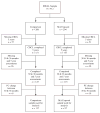Prenatal methamphetamine exposure, home environment, and primary caregiver risk factors predict child behavioral problems at 5 years
- PMID: 23330624
- PMCID: PMC3721329
- DOI: 10.1111/ajop.12007
Prenatal methamphetamine exposure, home environment, and primary caregiver risk factors predict child behavioral problems at 5 years
Abstract
This study investigated the prospective association between prenatal methamphetamine (MA) exposure and child behavioral problems at 5 years while also examining the home environment at 30 months and several primary caregiver (PC) risk factors. Participants were 97 MA-exposed and 117 comparison children and their PCs enrolled in the Infant Development, Environment and Lifestyle Study. Hypotheses were that child behaviors would be adversely impacted by (a) prenatal MA exposure, (b) home environments that provided less developmental stimulation and emotional responsiveness to the child, and (c) the presence of PC psychological symptoms and other risk factors. Prenatal MA exposure was associated with child externalizing behavioral problems at 5 years. Home environments that were more conducive to meeting children's developmental and emotional needs were associated with fewer internalizing and externalizing behavioral problems. Independent of prenatal MA exposure, PC parenting stress and psychological symptoms were associated with increased child behavioral problems. Findings suggest prenatal MA exposure may contribute to externalizing behavioral problems in early childhood and the importance of considering possible vulnerabilities related to prenatal MA exposure in the context of the child's caregiving environment.
© 2013 American Orthopsychiatric Association.
Similar articles
-
Developmental and behavioral consequences of prenatal methamphetamine exposure: A review of the Infant Development, Environment, and Lifestyle (IDEAL) study.Neurotoxicol Teratol. 2015 Sep-Oct;51:35-44. doi: 10.1016/j.ntt.2015.07.006. Epub 2015 Jul 23. Neurotoxicol Teratol. 2015. PMID: 26212684 Free PMC article. Review.
-
Prenatal methamphetamine exposure and childhood behavior problems at 3 and 5 years of age.Pediatrics. 2012 Apr;129(4):681-8. doi: 10.1542/peds.2011-2209. Epub 2012 Mar 19. Pediatrics. 2012. PMID: 22430455 Free PMC article.
-
Behavior Problems During Early Childhood in Children With Prenatal Methamphetamine Exposure.Pediatrics. 2020 Dec;146(6):e20190270. doi: 10.1542/peds.2019-0270. Epub 2020 Nov 10. Pediatrics. 2020. PMID: 33172920 Free PMC article.
-
School-Aged Outcomes following Prenatal Methamphetamine Exposure: 7.5-Year Follow-Up from the Infant Development, Environment, and Lifestyle Study.J Pediatr. 2016 Mar;170:34-8.e1. doi: 10.1016/j.jpeds.2015.11.070. Epub 2016 Jan 11. J Pediatr. 2016. PMID: 26781836 Free PMC article.
-
Prenatal exposure to opioids: Associations between the caregiving environment and externalizing behaviors.Neurotoxicol Teratol. 2021 Sep-Oct;87:107019. doi: 10.1016/j.ntt.2021.107019. Epub 2021 Aug 14. Neurotoxicol Teratol. 2021. PMID: 34403741 Review.
Cited by
-
Reduced fractional anisotropy in projection, association, and commissural fiber networks in neonates with prenatal methamphetamine exposure.Dev Neurobiol. 2020 Nov;80(11-12):381-398. doi: 10.1002/dneu.22784. Epub 2020 Oct 27. Dev Neurobiol. 2020. PMID: 33010114 Free PMC article.
-
Features and Associated Factors of the Behavioral Development of 24-month-old Children in Rural China: Follow-up Evaluation of a Randomized Controlled Trial.Sci Rep. 2018 Sep 18;8(1):13977. doi: 10.1038/s41598-018-32171-1. Sci Rep. 2018. PMID: 30228354 Free PMC article.
-
Developmental and behavioral consequences of prenatal methamphetamine exposure: A review of the Infant Development, Environment, and Lifestyle (IDEAL) study.Neurotoxicol Teratol. 2015 Sep-Oct;51:35-44. doi: 10.1016/j.ntt.2015.07.006. Epub 2015 Jul 23. Neurotoxicol Teratol. 2015. PMID: 26212684 Free PMC article. Review.
-
The Influences of Drug Abuse on Mother-Infant Interaction Through the Lens of the Biopsychosocial Model of Health and Illness: A Review.Front Public Health. 2019 Mar 12;7:45. doi: 10.3389/fpubh.2019.00045. eCollection 2019. Front Public Health. 2019. PMID: 30915325 Free PMC article.
-
Effects of Neonatal Methamphetamine and Stress on Brain Monoamines and Corticosterone in Preweanling Rats.Neurotox Res. 2017 Feb;31(2):269-282. doi: 10.1007/s12640-016-9680-y. Epub 2016 Nov 5. Neurotox Res. 2017. PMID: 27817108 Free PMC article.
References
-
- Abidin RR. Parenting Stress Index manual. Lutz, FL: Psychological Assessment Resources; 1990.
-
- Achenbach TM, Rescorla L. Manual for the ASEBA preschool forms and profiles. Burlington: University of Vermont, Research Center for Children, Youth, & Families; 2000.
-
- Arria AM, Derauf C, LaGasse LL, Grant P, Shah R, Smith L, Lester B. Methamphetamine and other substance use during pregnancy: Preliminary estimates from the Infant Development, Environment, and Lifestyle (IDEAL) Study. Maternal and Child Health Journal. 2006;10:293–302. - PubMed
-
- Billing L, Eriksson M, Jonsson B, Steneroth G, Zetterstrom R. The influence of environmental factors on behavioural problems in 8-year-old children exposed to amphetamine during fetal life. Child Abuse and Neglect. 1994;18:3–9. - PubMed
-
- Billing L, Eriksson M, Steneroth G, Zetterstrom R. Predictive indicators for adjustment in 4-year-old children whose mothers used amphetamine during pregnancy. Child Abuse and Neglect. 1988;12:503–507. - PubMed
MeSH terms
Substances
Grants and funding
LinkOut - more resources
Full Text Sources
Other Literature Sources
Medical


